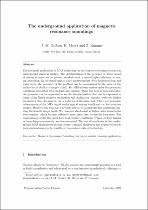JavaScript is disabled for your browser. Some features of this site may not work without it.
- ResearchSpace
- →
- Research Publications/Outputs
- →
- Journal Articles
- →
- View Item
| dc.contributor.author |
Greben, JM

|
|
| dc.contributor.author |
Meyer, R

|
|
| dc.contributor.author |
Kimmie, Zaheed

|
|
| dc.date.accessioned | 2011-09-26T08:08:09Z | |
| dc.date.available | 2011-09-26T08:08:09Z | |
| dc.date.issued | 2011-10 | |
| dc.identifier.citation | Greben. JM, Meyer, R and Kimmie, Z. 2011. Underground application of magnetic resonance soundings. Journal of Applied Geophysics, Vol 75(2), pp 220-226 | en_US |
| dc.identifier.issn | 0926-9851 | |
| dc.identifier.uri | http://www.sciencedirect.com/science/article/pii/S0926985111001091 | |
| dc.identifier.uri | http://hdl.handle.net/10204/5178 | |
| dc.description | Copyright: 2011 Elsevier. This is the pre print version of the work. The definitive version is published in the Journal of Applied Geophysics, Vol 75(2), pp 220-226 | en_US |
| dc.description.abstract | The potential application of MRS technology in locating water bearing fractures in underground mines is studied. The determination of the presence of water ahead of mining is important to prevent accidents and to ensure higher efficiency in mining operations. In the usual surface based measurements, with horizontal loop and water layer, the geometry of the problem can be summarized by the value of the inclination of the Earth magnetic field. For MRS measurements under the geometric conditions associated with underground mining, where the loop is non-horizontal, and the geometry can be expressed in an effective inclination that can be expressed in terms of the Earth magnetic inclination and declination, together with two further parameters that characterize the orientation of the mine wall. There is a geometric enhancement of the MRS signal under typical mining conditions for the locations studied. However, the loop size is severely restricted in underground conditions, limiting the feasible target depth. We therefore also looked at higher order terms in the wave number, which become relatively more important for smaller loop sizes. The consequences of the fractured hard rock aquifer conditions, typical of deep mining or tunnelling environments, are also examined. The overall conclusion is that under- ground MRS applications present severe technical challenges and require favourable local circumstances to be feasible at the current state of technology. | en_US |
| dc.language.iso | en | en_US |
| dc.publisher | Elsevier | en_US |
| dc.relation.ispartofseries | Workflow request;7282 | |
| dc.subject | Magnetic resonance sounding | en_US |
| dc.subject | Low water content | en_US |
| dc.subject | In mine application | en_US |
| dc.subject | Underground mines | en_US |
| dc.subject | Mining | en_US |
| dc.subject | Underground MRS applications | en_US |
| dc.subject | Applied geophysics | en_US |
| dc.title | Underground application of magnetic resonance soundings | en_US |
| dc.type | Article | en_US |
| dc.identifier.apacitation | Greben, J., Meyer, R., & Kimmie, Z. (2011). Underground application of magnetic resonance soundings. http://hdl.handle.net/10204/5178 | en_ZA |
| dc.identifier.chicagocitation | Greben, JM, R Meyer, and Zaheed Kimmie "Underground application of magnetic resonance soundings." (2011) http://hdl.handle.net/10204/5178 | en_ZA |
| dc.identifier.vancouvercitation | Greben J, Meyer R, Kimmie Z. Underground application of magnetic resonance soundings. 2011; http://hdl.handle.net/10204/5178. | en_ZA |
| dc.identifier.ris | TY - Article AU - Greben, JM AU - Meyer, R AU - Kimmie, Zaheed AB - The potential application of MRS technology in locating water bearing fractures in underground mines is studied. The determination of the presence of water ahead of mining is important to prevent accidents and to ensure higher efficiency in mining operations. In the usual surface based measurements, with horizontal loop and water layer, the geometry of the problem can be summarized by the value of the inclination of the Earth magnetic field. For MRS measurements under the geometric conditions associated with underground mining, where the loop is non-horizontal, and the geometry can be expressed in an effective inclination that can be expressed in terms of the Earth magnetic inclination and declination, together with two further parameters that characterize the orientation of the mine wall. There is a geometric enhancement of the MRS signal under typical mining conditions for the locations studied. However, the loop size is severely restricted in underground conditions, limiting the feasible target depth. We therefore also looked at higher order terms in the wave number, which become relatively more important for smaller loop sizes. The consequences of the fractured hard rock aquifer conditions, typical of deep mining or tunnelling environments, are also examined. The overall conclusion is that under- ground MRS applications present severe technical challenges and require favourable local circumstances to be feasible at the current state of technology. DA - 2011-10 DB - ResearchSpace DP - CSIR KW - Magnetic resonance sounding KW - Low water content KW - In mine application KW - Underground mines KW - Mining KW - Underground MRS applications KW - Applied geophysics LK - https://researchspace.csir.co.za PY - 2011 SM - 0926-9851 T1 - Underground application of magnetic resonance soundings TI - Underground application of magnetic resonance soundings UR - http://hdl.handle.net/10204/5178 ER - | en_ZA |






